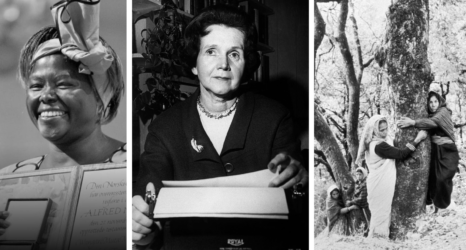For six weeks in the spring of 2013, Sheryl Sandberg’s Lean In topped the New York Times bestselling nonfiction list. About exactly 50 years before, Betty Friedan’s The Feminine Mystique accomplished the same feat. The timing may be a coincidence, but it is not accidental that Sandberg’s work resonates with Friedan’s book: According to Jodi Kantor of The New York Times, Sandberg reread The Feminine Mystique before starting her own book. She also calls Lean In “sort of a feminist manifesto,” and her language at times echoes Friedan’s.
Beyond Sandberg’s conscious efforts to invoke Friedan, however, we are struck by the many similarities between these two publishing moments. Although the two works’ differences signal the profound changes that have taken place over the last half century, their similarities suggest that the need for—and the possibility of sparking—a popular feminist movement is as alive today as it was in 1963.
Friedan and Sandberg grew up in comfortable Jewish families where education and engagement with the world were valued. Both went to elite schools and excelled in their chosen disciplines. Both were married with children, working outside the home, when they wrote their books. Both felt that something was not quite right and looked to women’s relationship to the world of work as the answer. And both, in their own ways that reflected the times in which they wrote, proposed an individual solution to a collective problem.
Although Friedan is remembered as a political activist, the first president of the National Organization for Women and a tireless crusader for women’s rights, her book, perhaps surprisingly for audiences today, did not urge structural political changes. Instead, Friedan proposed that women simply reject the “feminine mystique”—the cultural dogma that insisted that women define themselves and their worth through home and family. She decried “the girl who wastes her college years without acquiring serious interests, and wastes her early job years marking time until she finds a man.” To be sure, Friedan’s book was an attack on cultural institutions such as women’s colleges, magazines and advertising agencies that promoted messages of domestic bliss to young girls. But in the end, it was women themselves who needed to say “no” to the feminine mystique and embrace a “new life plan,” she argued in her final chapter.
Writing 50 years later, in a nation whose laws, economy, political system and culture have been revolutionized by the women’s movement but in which basic needs such as paid maternity leave are still largely unavailable, Sandberg insists that she is conscious of the need for structural change to improve women’s lives. She nonetheless focuses, just as Friedan did, on the internal obstacles women need to overcome. Women need to stay ambitious at work. They need to assert themselves in the workplace. They need to demand that their husbands do their 50 percent at home. They need to set parameters that allow them to productively combine work and family and not feel guilty when they do so. They need to recognize and resist double standards at work, and they need to help each other. Although Sandberg does not label them a mystique, she rightly punctures the cultural expectations and stereotypes that continue to define women as nurturing, caring and subordinate—primarily creatures of the home, not the workforce.
Both of these texts ignited significant political controversy when published, turning both authors simultaneously into iconic role models, celebrities and lightning rods.
These books are certainly different animals. Friedan’s is a dense literary indictment of American society in the middle of the 20th century, with evidence drawn from a rich mix of social science, cultural sources and surveys of women that she conducted. Although she refers a few times to her own life as a housewife, most of Friedan’s life experiences—including her associations with labor radicalism and her steady paid employment—are hidden from view in The Feminine Mystique. By contrast, Sandberg’s book is a far shorter, sunnier and lighter volume, much better suited to our sound-bite era. And in our confessional age, Sandberg makes herself the subject of her book. We learn about her family, education, jobs, mentors, husbands, moments of struggle and epiphany, how much weight she gained with her children and her many professional triumphs at the highest levels of corporate America. Although she peppers her work with many references to contemporary studies on gender dynamics and inequality, it is her own triumphs and struggles that are at the core of this book—and that have, thus far, won over many reviewers and readers.
While Sandberg certainly criticizes the business world’s tendency to discourage women rather than build in possibilities for women’s advancement, much of her book reads like a successful business case study. Her goal is to bring women into corporate America, not to question the fundamental assumptions of corporate capitalism, as Friedan’s chapter on “The Sexual Sell” did. As a woman grounded in the working-class labor movement of the 1930s and 1940s, Friedan reflected the grassroots activism of the middle of the 20th century, while Sandberg reflects the tech-happy corporate world of today.
It is possible, however, to make too much of the differences between these texts, to suggest that Sheryl Sandberg’s emphasis upon bringing women into the elite corporate world is not comparable to the revolution that The Feminine Mystique helped to inspire. As the labor of both middle class and working women are squeezed every day by technological change and political retrenchment, we think it is worth noting important similarities between these texts, and perhaps hoping that Lean In might energize a revived feminist movement that goes far beyond Sandberg’s goals of corporate parity.
After the publication of her book, Friedan said that she did not set out consciously to start a revolution. Her famous political activism actually came several years after her book was published. The celebrity that The Feminine Mystique earned her attracted the attention of political operatives who had been laboring quietly for years to fight women’s inequality in the workforce. They contacted Friedan, who was ready to move beyond the book, and worked with her to form the National Organization for Women in 1966. Friedan’s best-selling book brought her readers into this emerging women’s movement.
Might a similar narrative be told someday about Sheryl Sandberg? She has identified her own desire to be a part of a social movement, and has created a Lean In foundation and circles to encourage women to work together to put her goals into practice. If she were to unite with other women championing collective and structural changes in America, might she be able to bring her celebrity and her dedicated readers into a more thoroughgoing revival of feminist activism in this decade? Women and men working for social justice can only hope so.
The authors are co-editors of the recently published 50th anniversary, Norton Critical Edition of Betty Friedan’s The Feminine Mystique. Kirsten Fermaglich is a professor of history at Michigan State University and author of American Dreams and Nazi Nightmares: Early Holocaust Consciousness and Liberal America, 1957-1965. Lisa M. Fine is also a professor of history at Michigan State University, and codirector of its Center for Gender in Global Context. She is the author of The Souls of the Skyscraper: Female Office Workers in Chicago, 1870-1930 and The Story of Reo Joe: Work, Kin, and Community in Autotown U.S.A.
Photo of Sheryl Sandberg by Flickr user World Economic Forum, used under Creative Commons 2.0; photo of Betty Friedan from the Library of Congress, used under Wikimedia Commons.





